 Bill Senefsky
.
May 24, 2022
.
All Feature Vehicles
Bill Senefsky
.
May 24, 2022
.
All Feature Vehicles
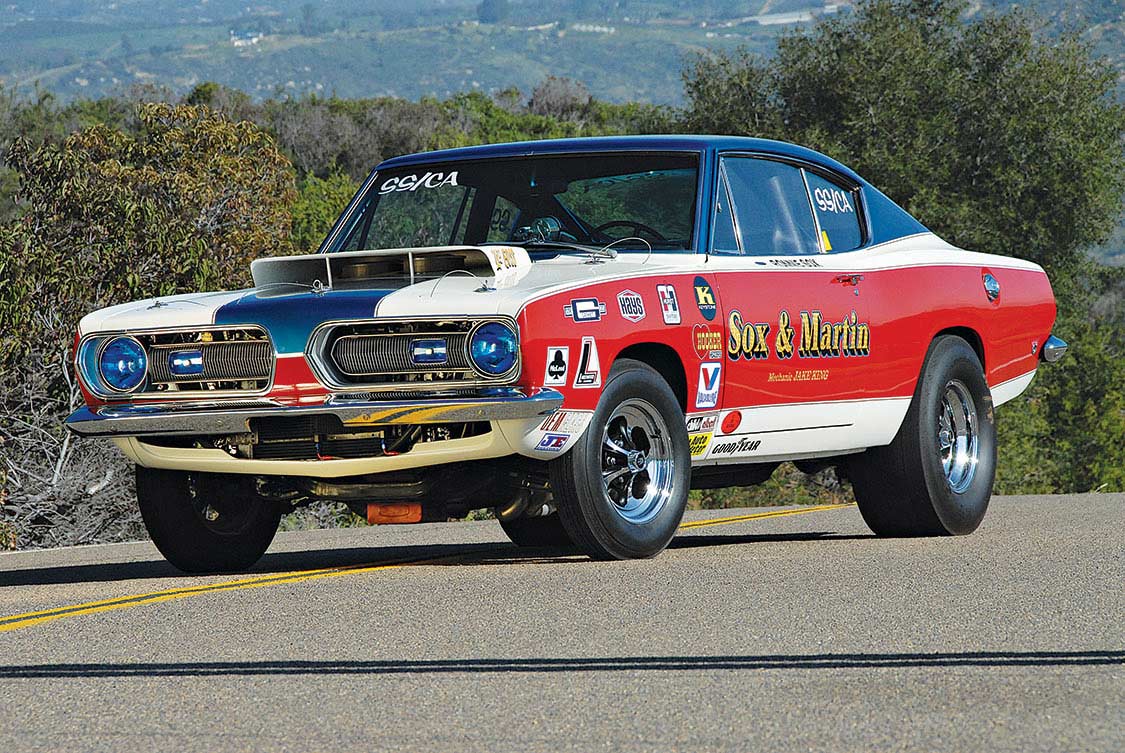
Chrysler Corporation’s Forward Look design of the late ’50s, including period-correct tailfins and all, were beginning to wane by 1961. The company’s styling team, led by Virgil Exner, was looking to dramatically change course with image, size and shape throughout the future platform line. The first of the team’s launches in September 1959 was the totally new Valiant platform aimed directly at the growing compact market.

This platform also showcased the company’s recommitment to engineering with the development of the slant-six engine. New and lighter eight-cylinder engines would soon follow for the rest of the corporate lineup. The new A-bodied Valiant was indeed radical in looks, and though initially launched as a four-door family sedan, several variants were in the wings. Soon a two-door coupe and four-door wagon would be added. A convertible would soon follow.
The sporty-car trend was really beginning to heat up by 1963, with all of the market players, including the independents, throwing their hats into the ring. Plymouth launched its entry, the Barracuda, on April 1, 1964. The platform hit the market two full weeks before the highly successful launch of the Ford Mustang. Originally dubbed internally as the “Panda,” several key program players wisely changed the name to Barracuda.
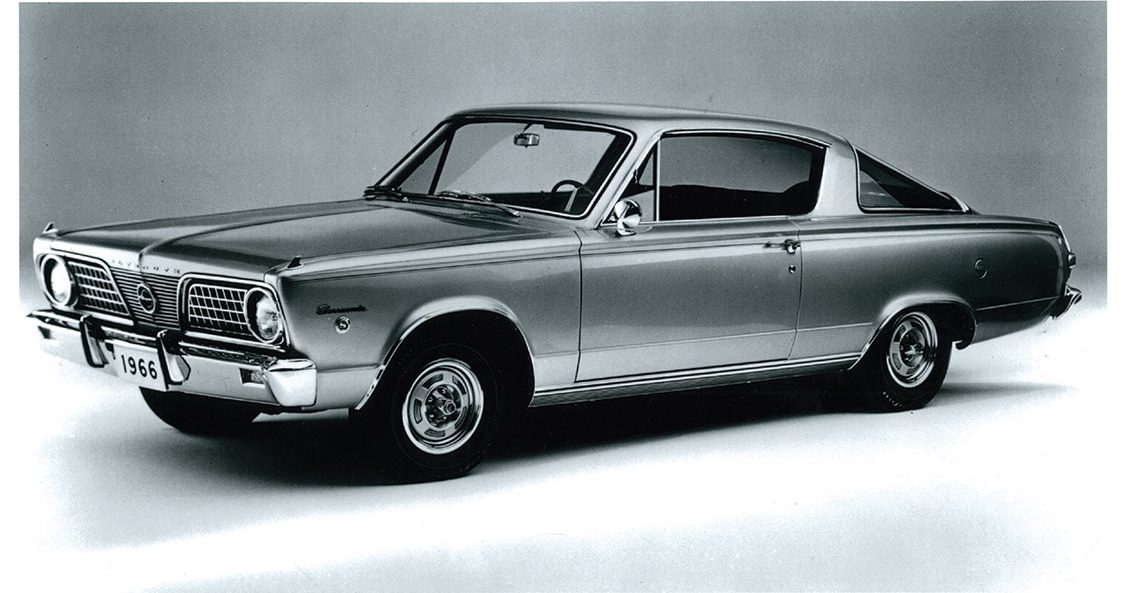
The new platform shared the Valiant 106-inch wheelbase along with major sheet metal pieces, exterior trim, bumpers and quarters. The obvious visual change was the inclusion of the massive rear window design, including 14.4 feet of rear window glass, which was developed jointly with Pittsburg Plate Glass (PPG). It was the largest in the industry during this period. As with the later Mustang, the Barracuda shared its mechanicals with the Valiant, as Ford did with its Falcon. The reasoning was obvious: It saved development and tooling as well as common component usage saved money. Plymouth’s new niche player pricing started at $2,512.
Chrysler’s new slant-six mills were offered in two variants: a standard offering of 170 ci (2.8L) developing 101 hp, with the optional version cranking out 145 hp from 225 ci (3.7L). True to form, Chrysler offered an all-new lightweight 273 ci (4.5L) V-8 developing 180 bhp with two-barrel carburetion. This was the first new mill in the corporation’s famous LA series.

As the newly dubbed pony car segment began to accelerate in popularity, refinements to the Barracuda were added for 1965. Chrysler now offered the 225-ci slant-six as its base engine in the United States. Canadian buyers, however, still had access to the 170-ci version. With regard to the V-8s, another high-performance version of the 273 was offered. Coded the “Commando V8,” the new upgraded version featured 235 bhp, along with solid tappets, a high-lift camshaft and 10.5:1 compression. A less restrictive exhaust system was also featured. The coded “Formula S” package on the order sheet bought the Commando 273 heavy-duty suspension pieces, larger wheels and tires, a factory tachometer and special body fender emblems.
Upgrades continued for 1966. The platform received new front sheet metal along with a new front grille design featuring massive box grille structure. The front sheet metal components continued to be shared with the Valiant series. New fender-mounted turn signals were offered as an upgrade item, shared with the rest of Chrysler’s lineup that year. The bumpers were larger and there were new taillights in the rear. For the interior, a new dashboard was featured with provisions for optional tachometer and oil pressure gauges, when ordered. A center console was also offered, though as optional equipment. Formula S Barracudas also appeared with the performance stripe over the roof.
The first generation Barracudas were strongly linked to the Valiant series, with the 1964 versions including the Valiant signature script and trim appearing under the rear window of the 1964 platform. By 1966, a brand-specific Barracuda emblem appeared instead. All export models of this unique platform continued with the Valiant signage until generation two.
The booming sales of Ford’s Mustang both perplexed Chrysler management and led its engineers to a massive redesign of the Barracuda for 1967. The new platform was broadened into three models, including a convertible and notchback coupe, all riding on a longer 108-inch wheelbase. The latest version featured strong Coke bottle styling influences along with distinctive front and rear styling themes.
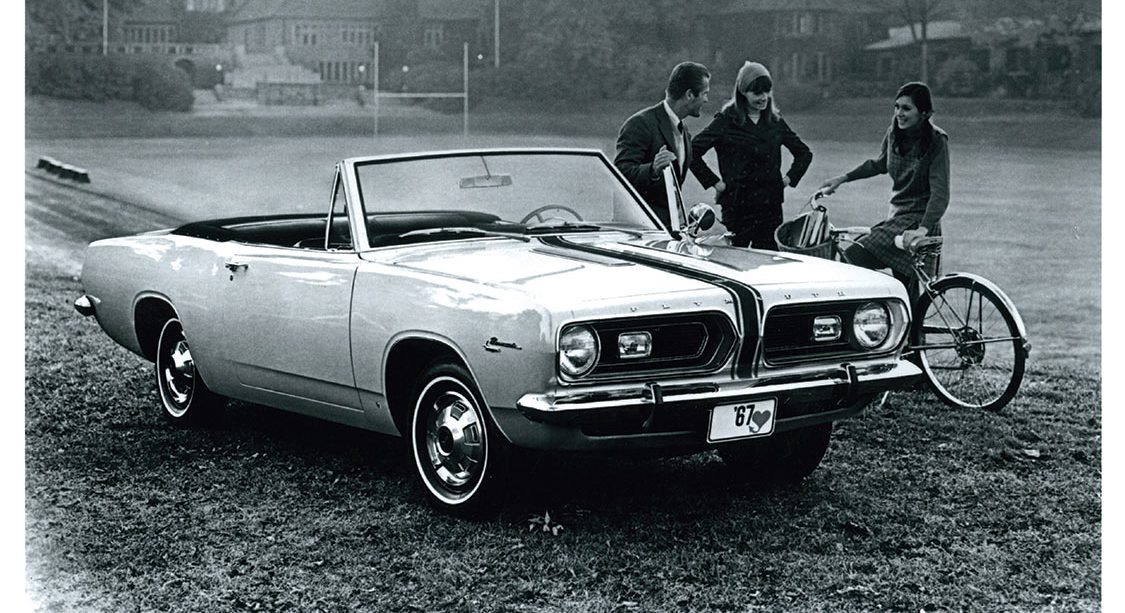
The notchback two-door offering had a tendency to elicit a love it or hate it attitude with consumers. The concave rear deck design was a distinctive touch. New curved side glass, full-wheel openings and a noted lack of chrome trim rounded out the latest package. Unique features such as the Lemans-style gas cap and dual front grilles added to the styling cues. Though the platform continued to share many Valiant internals, they certainly were less obvious. On that note, the front and rear bumpers on these platforms were identical. On the fastback offering, the earlier massive distinct rear window glass area was greatly reduced and incorporated a more rakish appearance.
Finding itself squarely in the horsepower race of this new segment, engine offerings in 1967 included the carryover 225-ci (3.7 L) slant-six, two versions of the established 273-ci V-8 with two- and four-barrel carburetion and a new 383-ci (6.3L) big-block. The latter was offered in the Formula S package only.
The pony-car market was beginning to get crowded with the inclusion of Chevrolet’s Camaro, Pontiac’s Firebird, Mercury’s Cougar and AMC’s Javelin, so Chrysler’s engineers revised their powertrain offerings for the Barracuda. The 273-ci V-8s were replaced with the 318-ci (5.2L) LA engine. A new 340-ci mill was added and found a popular following. The new 340 was based on 273 architecture, but Chrysler engineers kept pushing the envelope with a performance edge. A new 383 Super Commando big-block found its way into the Barracuda as well. A derivative of the standard high-performance mill found in the Roadrunner and Super Bee, this offering shared the high-performance heads, intake manifolds and camshafts. The performance exhaust manifolds ended up being more restrictive, however, due to the tighter quarters of the A-bodied engine compartment.
This new Barracuda version had a factory horsepower rating of 300 bhp. Chrysler continued its drag racing interest with the addition of the Sox and Martin race clinics held around the country in conjunction with its factory racing activities. This same year found the introduction of 50 A-bodied Barracudas subcontracted by Hurst Performance specifically for drag racing. These fastback platforms were equipped with Chrysler’s new 426 Hemi (7.0 L) engine launched in 1964. These platforms were meant for serious drag racing use only, and were spec’d by the factory as such. Equipped with stripped down interiors, plastic window side glass and fiberglass hoods and front fenders and bumpers, these fastback thunderers ran the quarter-mile in the mid to low 10-second range.
On a side note, Barracudas continued to be exported to other parts of the world with different power plants. Chrysler South Africa produced a 225-ci slant-six version dubbed “Charger-Power six,” it featured 190 bhp. This rare mill featured 9.3 x 1 compression, a high-lift camshaft and low-restriction exhaust and upgraded suspension.
For 1969, the last second-generation year, Barracuda platforms featured other engine changes. First, the venerable 383 had a horsepower increase to 330 bhp and a new ’Cuda trim package was announced. It was a modified version of the previous Formula S offering which now included the 340, 383 or a new 440 Super Commando mills.
Chrysler’s performance beat went on for Plymouth and its Barracuda for 1970. A totally new body shell was developed with the new model range reduced by one. Only the new coupe and convertible remained, but the result was a styling cue. The best news for the purists was the elimination of the Valiant ties. The new E-body platform was shorter and wider and was shared with Dodge’s new Challenger. The Challenger ironically shared no sheet metal with the Barracuda and was in fact 2 inches longer.
Three variants of the new platform were offered: a base version (BH), grand coupe (BP) and the ’Cuda (BS) high-performance version, which was a carryover. The big news for enthusiasts was the fact that the new E-body platform could hold all of Chrysler’s high performance engines including the 426-ci Hemi.
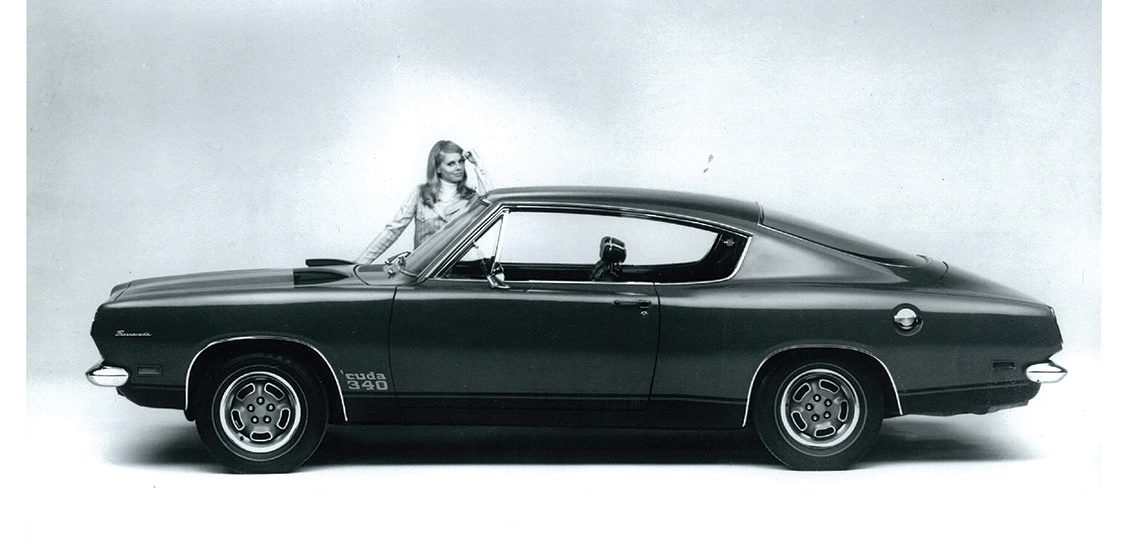
The standard mills offered were the venerable 198 and 225-ci slant-sixes, along with the 318 ci (two-barrel), two versions of the 383 with two- or four-barrel carburetion, the latter developing 330 hp with dual exhaust. On ’Cuda versions, its standard 383 delivered 335 hp parallel to Dodge’s Magnum version.
But what an option sheet the ’Cuda offered! The 440-ci four-barrel Super Commando, 440-ci Super Commando Six-Pak,and the 426-ci Hemi rounded out the list. The latter’s options truly made them race cars for the street and demanded the extra heavy-duty suspension, cooling and internal pieces. Dana 60 axles with heavy-duty gearing were standard fare with the high-end-powered four-speed platforms, but they could be had with the automatics.
The Barracuda option list of this period was certainly centered on performance with wild color choices such as Moulin Rouge, In-Violet, Vitamin-C and Sassy-Grass-Green. Assorted decal graphics were also introduced during this period. Of particular interest were the Air Grabber hoods. These pieces were offered for the 340, 383, 440 (four barrel and six barrel)and 426 Hemi mills.
Though arriving late to the table, Plymouth offered its version of a Barracuda for the then-popular Trans-Am Sedan racing series. Introduced during 1970, the AAR ’Cuda featured limited production and was powered by a unique 340-ci Six-Pak mill. The exhaust pipes were mounted NASCAR style in front of the rear wheels and the body trim was accented by unique paint trim and assorted decals. A factory-mounted spoiler rounded out the rear. The car was raced by Dan Gurney and Swede Savage with no particular success. Its tri-powered production mill was not legal or used in the Trans-Am racing series.
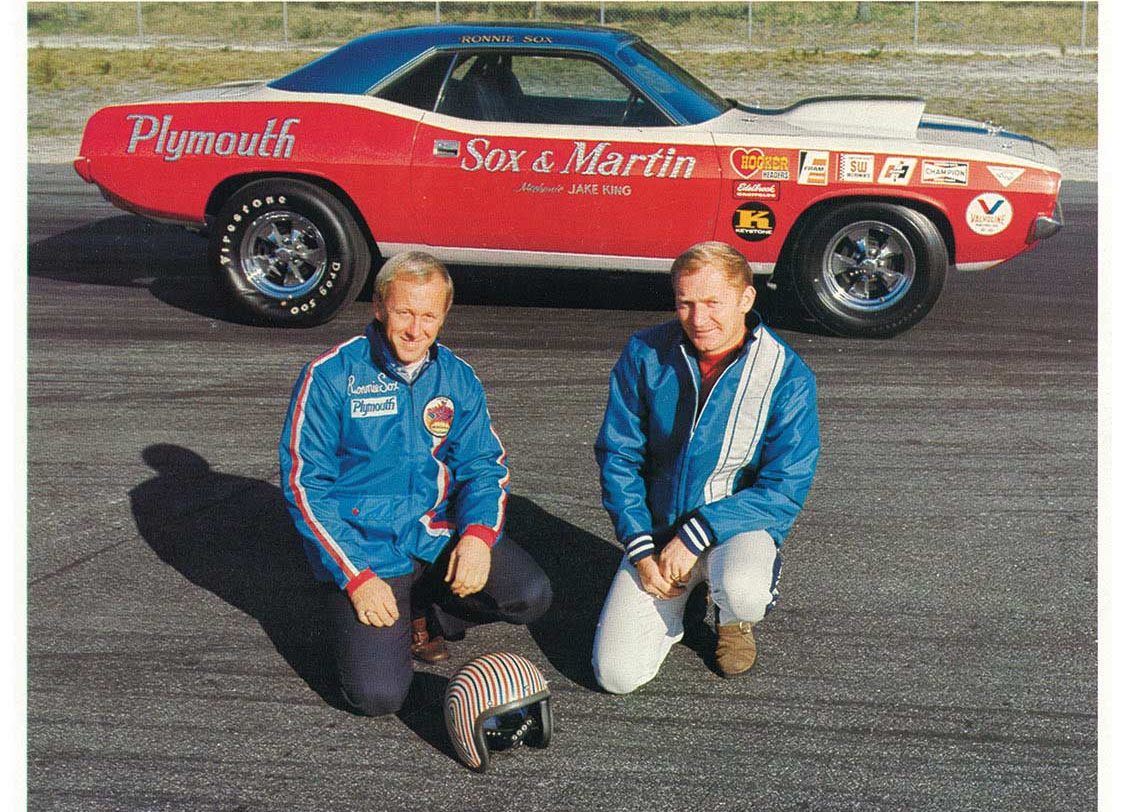
Traditionalists believe that marketing trends originate on the West Coast and travel east. New California emissions regulations entered the automotive market with a vengeance in the late ’60s and suddenly the other 49 states started feeling the results of the newly formed EPA’s wrath.
By 1971, major changes were in the wind with regard to high performance. The automakers reset their horsepower output numbers lower to combat government and new insurance surcharges. Body structures, by federal mandate, now contained structural beams in the doors, and bumpers were becoming heavier for crash protection.
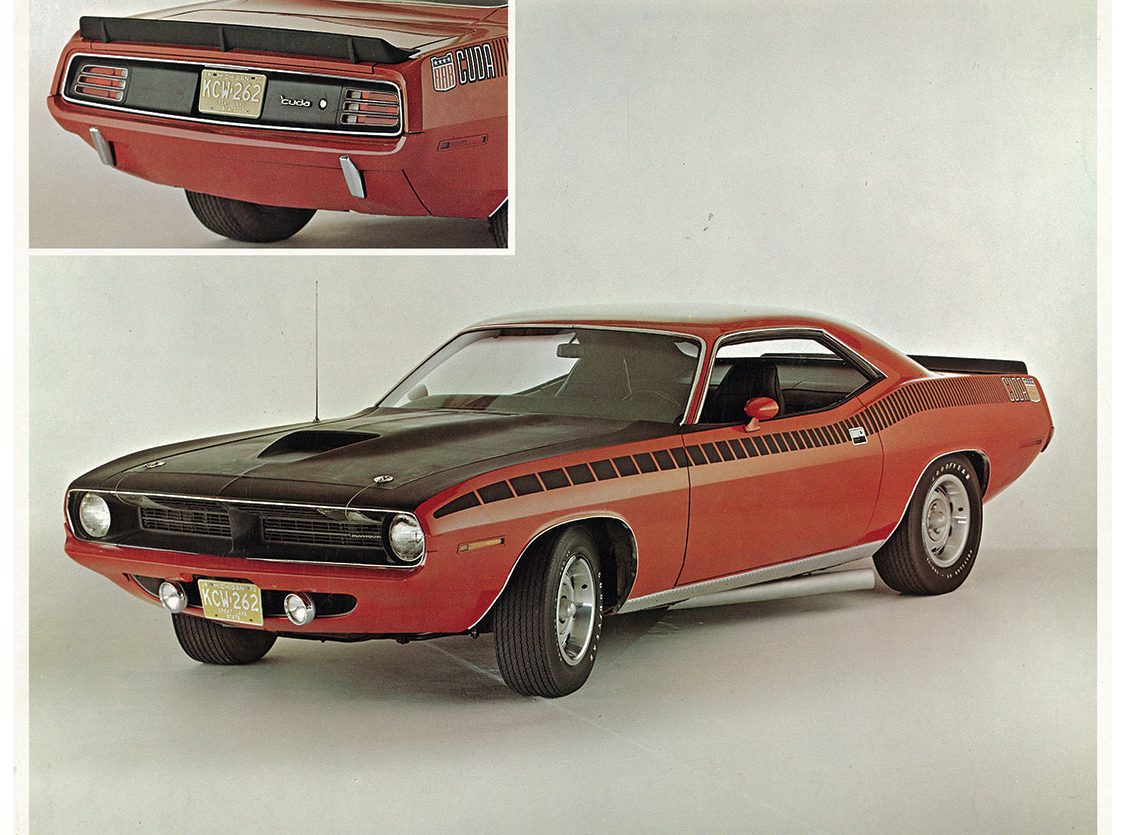
Barracuda’s revised offerings with regard to big-block output ratings were 383 (4v) SAE rated at 250 hp, with the 440 (6v) downgraded to 330 hp SAE. Appearance changes were minimal with doodad chrome mini-strips added to the front fenders, along with a weird grille design featuring a toothy pattern and double headlights. Modified rear taillights, interior trim and paint options rounded out the appearance packages.
One year later, the Barracuda was rapidly losing its performance heritage. The big-block 383, 440 and 426 Hemi engine were dropped, along with the performance suspensions, rearends and the larger wheels and tires. Surprisingly, comfort and convenience items were also canned. Power seats, windows and leather upgrades, along with deluxe carpet options were also cancelled.
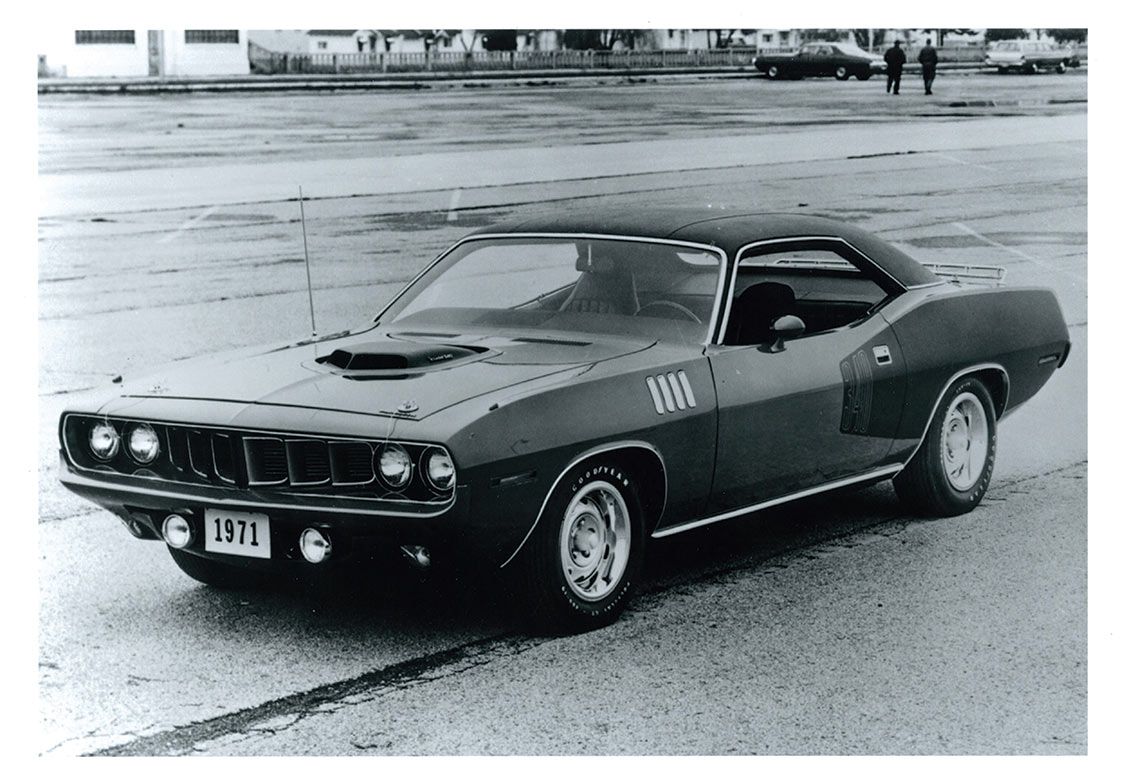
In 1972, further reductions were noted. Prospective buyers now had only three engine choices available: a 225-ci in slant-six, the venerable 318 and 340 V-8s, both drastically detuned for emission purposes. The 318 engine was the standard mill available in both the Barracuda and ’Cuda. Style-wise, the platform returned to its single headlight dual front grille featuring strong cues from 1970. A circular four-taillight design brought up the rear, and federal bumper requirements were added. New body striping rounded out the package,
Only two engine choices were available in 1973. The 318 and 340 soldiered on with the demise of the 225 slant-six. Some relief was in store with the addition of Chrysler’s emission engine, the new 360 that appeared in Barracuda in 1974, replacing the 340. Surprisingly, the four-speed manual transmission remained and when mounted to either the 340 or 360 V-8s.
During Barracuda production, its high sales point occurred in 1970, with a slight increase noted in 1973. As with its competitors in the pony car market, government emissions and insurance surcharges killed these popular platforms’ sales. On April 1, 1974, Plymouth produced the last of the unique platforms.
Share Link